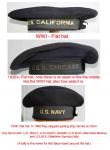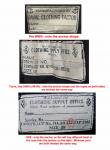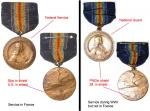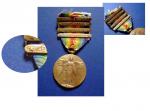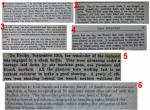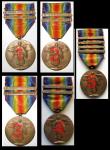-
Posts
461 -
Joined
-
Last visited
Content Type
Profiles
Forums
Blogs
Gallery
Events
Store
Everything posted by johnnymac
-
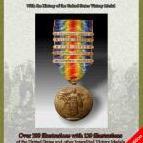
American (US) Victory Medals
johnnymac replied to Kev in Deva's topic in Inter-Allied Victory Medals of the Great War
Hi Rob, This type plus, several other types may have came from BB&B, George Studley and others. But who was their supplier is any ones quess P.S. good to see you back. Regards, Jim. -

WW1 Victory Medal with clasp SERBIA
johnnymac replied to bovec1313's topic in United States of America
Tim & Kevin To both of you, I agree the market was for the veterans. I further agree that person's put some of these campaign clasps on the proudly fight for victory medal they were awarded. That is not the question. Identifying what was an issued, authorized or official item, and how do you class things that are not official, to me is the real question. There are so many who do not know the differences between, Unofficial, Copy, Unauthorized, Fantasy, Bogus and Fake, that these words become meaningless (when selling). Yes without doubt veterans purchased these type clasps. But I marked your top two clasps as"Fantasy or Bogus" to help a new collector who might put good money thinking he found a rare item. Marking claspsthis way just might save someone money. On a personnel level, I enjoy and own a set of 17 different clasps from this same Mfg as shown on your posted medal. I to believe the veterans would have remembered these smaller campaign battle as it was "up close and personal" for them. As children, we held storiesof war like Belleau Woods. St. Mihiel,Ypres-Lys and places like these, were the General offensive battles and most veterans did not even know these names. To me I believe some of these type clasps are very collectible and are becoming hard to find. I ask you to post a photo of the brooch, because from the looks of your suspension ribbon this medal might be one of three, G. Studley, J.K.Davison or even BB&B. Jim -

HELP WITH US NAVY BLUE WOOL SAILOR CAP
johnnymac replied to SICHERHEITSDIENTS's topic in United States of America
Hi I posted a reply, Jim -

HELP WITH US NAVY BLUE WOOL SAILOR CAP
johnnymac replied to SICHERHEITSDIENTS's topic in United States of America
-

HELP WITH US NAVY BLUE WOOL SAILOR CAP
johnnymac replied to SICHERHEITSDIENTS's topic in United States of America
Hi Captain Albert, A lot of people think that the 1933 is the date when fact it is the TAP contractors no. Regards -

HELP WITH US NAVY BLUE WOOL SAILOR CAP
johnnymac replied to SICHERHEITSDIENTS's topic in United States of America
Yes and that dates back to the 1860's (some of the bow end were longer up to the 1930's) -

WW1 Victory Medal with clasp SERBIA
johnnymac replied to bovec1313's topic in United States of America
Hello Tim, The top two are fantasy or bogus (never were) clasps. The Siberia clasp has stars on each end, because of this, I would list this clasp as an unofficial as there was a Siberia clasp (but it was without stars). Can you post a photo of the reverse side, my interest is the brooch, as I might be able to ID who put this together. Regards Jim -

HELP WITH US NAVY BLUE WOOL SAILOR CAP
johnnymac replied to SICHERHEITSDIENTS's topic in United States of America
1921 - Schuylkill Arsenal renamedPhiladelphia Quartermaster Depot 1948 - Defense Agency Center 1962 - Defense Industrial Supply Center evolves 1965 - Defense Personnel Support Center established 1998 - Defense Personnel Support Center renamed Defense Supply CenterPhiladelphia 1999 - Defense Industrial Supply Center and Defense Supply CenterPhiladelphia merge 2010 - Defense Supply Center Philadelphia renamed DLA Troop Support Luck with your hat -

HELP WITH US NAVY BLUE WOOL SAILOR CAP
johnnymac replied to SICHERHEITSDIENTS's topic in United States of America
-

HELP WITH US NAVY BLUE WOOL SAILOR CAP
johnnymac replied to SICHERHEITSDIENTS's topic in United States of America
I still do have my flat hat which I was issued in Nov. 1962 - 1966 Navy, 1966 -1968 Res. Navy, and its mint cond. as I never got to wear it. Regards, Jim -
Hello to all, There are two types: the first is "National Guard" and the second is Federal Service. The 1st was issued to those who were not sent to France for manyreasons but were serving during the war. The 2nd type was for those sent to France. Both are from J.K. Davison's and both came in the same marked box. There was a large surplus of the National Guard medals that is why you will still find them in mint cond. Regards, Jim
-

HELP WITH US NAVY BLUE WOOL SAILOR CAP
johnnymac replied to SICHERHEITSDIENTS's topic in United States of America
-

HELP WITH US NAVY BLUE WOOL SAILOR CAP
johnnymac replied to SICHERHEITSDIENTS's topic in United States of America
Regards, Jim -

HELP WITH US NAVY BLUE WOOL SAILOR CAP
johnnymac replied to SICHERHEITSDIENTS's topic in United States of America
They stopped issuing them in April 1963. The ship or station decided what the uniformof the day. The norm was the Dixie cup (sailorslang) or the white hat. After 1958 theflat hat (your hat) was stopped being worn officially. The Navy issued you the flat hat as part ofyour sea bag (kit) until supplies ran out. The tally or the flat hat ribbon, had the ship or stations name on ituntil 1941's, then they issued you the U.S. Navy tally, because of thewar. Although, the "U.S. NAVY" tally wasbeing worn prior to WWI most people think it was used only used during WWIIperiod. This hat was known in the late 1890'sas the pancake hat. (sailor slang). I posted a sailor from around the 1918's. Regards, Jim -

American (US) Victory Medals
johnnymac replied to Kev in Deva's topic in Inter-Allied Victory Medals of the Great War
Hello Lamber & Rob, Here are my thoughts on the Defensive Sector clasp, I used a Time line & Doc's January 1919, General Pershing submits a list of named battles and campaigns. April 1919, WD G.O No. 65 The Cambrai clasp was adds to the list of War Department, General Order No 48. June 1919, WD G.O. No. 48, The Secretary of War, amended & included the Defensive Sector clasp. June 30, 1919, WD G.O. 83, Consolidates all the changes made to WD G.O. 48. March 27, 1920, The Army approves the contract for the Victory Medals, with the 3 contractors April 3, 1920, All dies & hubs started to be sent out by Philadelphia Mint, to the three approved contractors. April 6, 1920, The Army's (dated) application form # 740, for the Victory Medal, tells us a lot. 1) It tell us that no Victory Medal was ordered before this application form was available. 2) It also tells us it was eight months after the defensive Sector clasp had been approved. 3) It also confirms that the defensive sector was approved, there is a detailed section box to be hand written in for just filling out for the Defensive Sector service clasp, - see instructions (3) which is listed in that box. Circular letter WD 3-7740 - Are the instructions which came with the application form # 740. (April 6, 1920 is the date the form was approved). April - June, 1920 It took the contractors time to strike the medals and all the clasps. And it took time to ship everything out to the one collection center which was the Philadelphia Quartermaster Depot. The Philadelphia Quartermaster Depot held all the Army's records and they also would have needed time to process all the applications. (The three contractors had no way of knowing who was entitled to what, and for what reason he was entitled to it). That is why there was only one military collection center for the Army. And that is why no Army medals were send out by contractors. Just think what a nightmare it would have been had all three contractors had the Army's records. June 21, 1920 - General distribution of the Victory Medal to Army personnel was begun. The Defensive Sector and battle claps were put in place by WD G.O 48, being reinforced by the following document, G.O. 83. The distribution happened a full ten or more months after the War Department rejected the notion of there being a 1st Army, 2nd Army or an Army of Occupation clasps. It should be without question, reasonable to believe the award committee had worked out the all the finalizing details in that time period. Looking at the very few Defensive Sector clasp which are found as the top clasp, still having their spacer bars attached. This can be explained by saying, with the mad rush to get millions of medals out the door. 1) A new employee might mistakenly placed the Defensive Sector at top and had just forgotten to remover the spacer bars. This is understandable and reasonable as to how a clasp could got out that way. But the more likely reason would be, an un-knowing or an unknowledgeable person,privately took some intervention into the life of this medal. As has been found to be the case in most situations. 2) Why the spacer bars are sometimes found on the clasps is also understandable. The Philadelphia Mint had all the dies and hubs made before the contracts were issued. Most of these early dies were made with the possibility of another clasp being issued. Again, it is reasonable as most Defensive Sector clasps had to have their two spacers cut off at some point, and the old supply had to be used up until the newer dies arrived from the mint. A few missed the cutting out of the spacers. 3) The placement of the Defensive Sector clap is for a practical reasons, why, because the sequence of the battles, the defensive sector clasp placement should stand unquestioned. This clasp was awarded not for a major operation, and as such the protocol would be no different then a soldier wearing his medals or ribbons on his chest. 4) If any other countries medals were found with its battle clasps or bars in any other sequence then the battles fought or awarded. That medal would be heavily questioned by collectors and shunned, so why is it not so for the United States Victory Medal. Again best regards, Jim -

American (US) Victory Medals
johnnymac replied to Kev in Deva's topic in Inter-Allied Victory Medals of the Great War
Sorry for getting into this thread late, but I had pressing needs Rob, If you look a little closer you will see there is a large piece of a spacer bar at the bottom of the Meuse-Argonne clasp, which means at some time the spacers were removed? And it was not to be the bottom clasp. Regards, Jim -

American (US) Victory Medals
johnnymac replied to Kev in Deva's topic in Inter-Allied Victory Medals of the Great War
Gentlemen. I realized that my medal victory USA. with this clap "defensive sector" inverted. . This would be the last in the medal ribbon .. more pics http://medalhasdegue...a-1-guerra.html lambert -

American (US) Victory Medals
johnnymac replied to Kev in Deva's topic in Inter-Allied Victory Medals of the Great War
To All (Old subject) I received another personnel email about Bailey, Banks & Biddle clasp in A. Laslo's book so I'll post my answer. 1. We know that they made Navy clasp because their designwas approved, but they lost the contract. 2. The design of the, Army of Occupation clasp is mentioned in Laslo's book. On page 119, Laslo touches on the subject of the "Army of Occupation" clasp,which he listed as an unofficial clasp. Mr. Laslo wrote, "Manufacturedby Bailey, Banks & Biddle. "Appears" in George W. Studley's 1939 catalog for $.25 each".This tells me, that Mr. Laslo did not personally have knowledgeof the clasp even being an unofficial clasp of Bailey, Banks and Biddle, rather he was relying on a catalog for his documentation on this clasp. 3. Would it be logical for BB&B to redesign a Navy clasp when they already had a approved version - no. Why not sell the old approved one? 4. Would it be logical for BB&B to design 17 Campaignclasps when it was never needed or would be ever be approved by the Army - no. 5. Would it be logical for BB&B to make a Army & Service clasps far different then the authorized issue style - again no. 6. We know that BB&B put their logo on the approved Navy clasps - so why not on the four clasp types listed above? 7 Bottom line - George Studley put the Army of occupation clasp in his catalog and listed it as a BB&B - To make it more saleable. Jim -

American (US) Victory Medals
johnnymac replied to Kev in Deva's topic in Inter-Allied Victory Medals of the Great War
I do not agree with your statement (4,800 personnel being entitled to the Italy service clasp would have to be revised downward as well)and here's why. The "Italy" clasp: There were 500 Air Service pilots training in Italy just before the battle of Vittorio Veneto. They would have had crew members (machine gunners), ground crews and mechanics' to service the new type bomber, they to would need training. And lets not forget supply and support units for this group of Air Service men. To me that would account for about maybe 1,200-1,500 men in that group in Italy. The Navy also sent pilots for training. There were U.S. Subchaser bases in Italy. As we know in 1940 the Navy Dept. allowed the Naval personnel to be awarded the Army's clasp for service in Italy. To me all that would cut into the number4,800. If the 332nd Inf. in Italy, only had 1,200 are we to believeno officers, support units or bomber crews were any where near the battle, ofcourse not. I have read somewhere that others believe that the number should bearound 2,500 Vittorio Veneto medals. The "Russia" clasp: The 339th Inf. 1,200 menstrong, and 310th Eng. lets say had 500-800 Engineers who were sent to Russia,I ask? who were the other 7,000 men? The "Siberia" clasp: The 27th & 31 Inf Regiments. from the Philippine Division (cut to800 men each because of their location to the war). were sent to Siberia, yet they were awarded around 9,000clasps. Who were the other (7,400) awardedtoo? Adding to the mix, in both cases the soldiers from theRussia and Siberia campaigns were entitled to either the battle clasp DefensiveSector (if they were engaged as a combatant and many as we know did fight anddied in Russia). Or, they could just request the Service clasp "Russia - Siberia". I am sure many would taken the"battle" clasp Defensive Sector and that could add at least another4,000 clasps. To recap we awarded 9,000 to Russia, 9,000 to Siberia and maybe 4,000 (or more) with the Defensive Sector clasp for a total of at least 22,000 men. If the 339th Inf. & 310th Eng. had 2,000 men and the27th & 31st Inf. had 1,600 men plus there were 4,000 combatants who werethe other 16,400 men? Support units? This bring me full circle. If the Russia & Siberia campaigns netted 22,000, why do feel 4,800 clasps for Italy is to be lower? I am heading out the door on a trip and wrote this reply on the fly. Jim -

American (US) Victory Medals
johnnymac replied to Kev in Deva's topic in Inter-Allied Victory Medals of the Great War
Its a type-o, and I am sure you have seen this before. As for 369th Inf. serving with the French Army? Half the U.S. Army served with and under French and English commands and that's not to mention also the Italian's command with the 332nd Inf at Vittiorio Veneto Was not the U.S. Grand Fleet under UK commander, and U.S. 27th & 30th Divisions under UK command almost to the end of the war! Jim -

American (US) Victory Medals
johnnymac replied to Kev in Deva's topic in Inter-Allied Victory Medals of the Great War
I think this might be faster then looking for a book(s) From the book "In Italy with the 332nd Inf." 1. HQ, 331st Field Hospital and machine Gun Co. 2. Trench Mortars, Supply officer 3. "Our"Machine Gun men 4. 4000 men washing in ditch, 200 officers washing in river 5. "Our" Machine Gun, One pounders (small artillery)and Trench Mortars. To support the Machine Gun Companies., Mortars, Artillery and Infantry you need "Ammo trains for each" that is why we get back to what they wrote in their book "4000 men washing in a ditch" (not shown in these grouping, but a "Company Band" is also mentioned". From the Book "Doughboys in Italy 6. Medical and supply units, 30 American ambulance sections, a Base hospital and 54 American pilots (+ crew) on a bombing raid Vittorio Veneto . Wiki - American bomber pilots Vittorio Veneto The old break down for the Army was: A company had 100 men and 12 companies to regiment or 1,200 men that was not counting support units (we can not believe no one else was at the battle). The 332nd Infantry needed, food, ammo, everyday supplies, HQ, MP's, medical aid and supplies, field phones and list goes on. It would be hard to believe they got off the ship and said "we are here". Just think, possible 99.9% or more did not speak Italian, we know this as they did not seek only men that spoke Italian. Jim -

American (US) Victory Medals
johnnymac replied to Kev in Deva's topic in Inter-Allied Victory Medals of the Great War
see below - Jim I put everything on one post -

American (US) Victory Medals
johnnymac replied to Kev in Deva's topic in Inter-Allied Victory Medals of the Great War
Changing Subject Overlooked little Giants, as most collectors go for the 5 to more clasps medals. 1. 301st Tank Corps, (1st U.S. Tank battle). - Also, only personnel actually engaged in the battle of the Somme, Offensive. Other possible reasons: This was their first and their only battle, wounded to degree that they could not returned to full duty or were POW's returned after war. 2. 11th, 12 or 14th Engineers, (1st battle where U.S. troops fought). - Also only personnel actually engaged in the battle of Cambrai. Other possible reasons: This was their first and their only battle, wounded to degree that they could not returned to full duty or were POW's returned after war war. 3. Naval Railway Battery No 1 and 370th Infantry (93rd Div.). - Also only personnel actually engaged in the battle of Oise-Asine. Other possible reasons: This was their first and their only battle, wounded to degree that they could not returned to full duty. (The Naval Railway Batteries Gun No.1, 2, 3, 4 and 5 "Gun crews" they were authorized and awarded Army type clasps, along with the Sailor's and Marines with the 2ndDivision, See their history and Alexanders Lasol's book). 4. 332nd Infantry, 331st Field Hospital, 30 American ambulance sections, Supply and Ammo Trains, Machine Gun and Trench Mortar battalions and 54 U.S Air Service pilots plus their crews (who did bombing raids during the battle of Vittoro Veneto). - In their book they mention 4000 enlisted men washed themselves in what they called the ditch and under 200 officers used a river less than one mile away. So maybe that number 1,200 victory medals with the clasp Vittoro-Veneto is low. 5. 2nd PursuitGroup, Air Service, 1st Army, 22 Squadron. These combination are unique and were awarded only to these units. That is not say that some individuals did not receive the same combination. Jim -

American (US) Victory Medals
johnnymac replied to Kev in Deva's topic in Inter-Allied Victory Medals of the Great War
To All, We know that BB&B tried to get the Navy clasp contractbut failed. They lost out to Fulford Manufacturing Company and at a later date to the Art Medal Works. However, BB&B did make Navy clasps. We know this because there are clasps with their BB&B logo on them. These may be the ones used for the bidding contract with the Navy. And the amount of clasps made for the bidding, I believe may be very small. We also know that Art Medal Works, S.G. Adams and Jos.Mayer's won the Army's contract. So I ask you, did BB&B even make a Army type clasp? I ask this question because you would think that at least one Army clasp in the past 90 years would have turned up with their logo onit. BB&B's military section was just a small part of their business. Might not have BB&B used someone else's unofficial Army clasp as needed? We know this practice of outsourcing was wide spread in Europe on their medals, because there so many unofficial types. To support this statement I offer these thoughts. The U.S. Government was sending out millionsof medals from three different manufacturers for free during hard times. BB&B was an elite business with a limited market. In the 1920's, they had little to no capability of reaching the mass of veterans on a large scale to justify stock piling millions of different battle and service clasps. I believe having a small customer base, it would have made good business sense to outsource for clasps. Returning to the subject of the "Army of Occupation" clasp, Mr. Laslo wrote, on page 119, "Manufactured byBailey Banks & Biddle. Appears in George W. Stubley's 1939 catalog for $.25 each". That tells me, that Mr. Laslo did not personally have knowledge of the clasp being a BB&B, rather he was relying on a catalog for his documentation on this clasp. Until an Army clasp with the same known markings "BB&B Bronze" which is on the Navy clasp shows up, for me the case is closed. I have seen many other type military collector books that were labeled as the bible in their field, only to find at a later date, a newer one at some military collector show. Thank you for your patience, Jim P.S.When I moved to another state to a smaller home, many of my collectible things had to go. One of these unknown to me at the time, was my copy of Gleim Medal Letters 1971-1997, 2nd ED. I am looking for another copy in any condition. If anyone can help, it would be greatly appreciated. Thanks. -

WW1 Victory Medals General Discussion
johnnymac replied to JimZ's topic in Inter-Allied Victory Medals of the Great War
Thanks for reading all the Vic posting, From one Jim to another Jim



